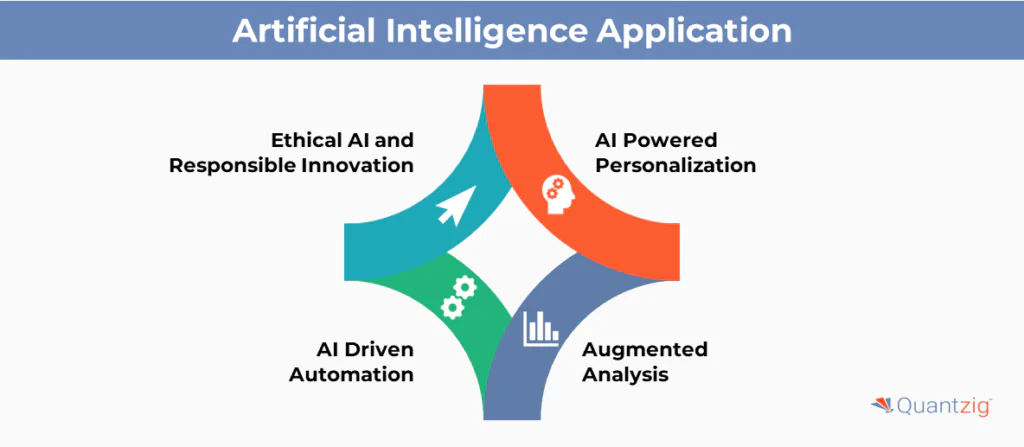Written By: Medha Banerjee
The advancements in technology, increasing investments, and the competition for skilled talent are converging toward a singular outcome: By 2024, artificial intelligence (AI) is set to commence a significant transformation in how businesses operate. This transformation will affect revenue generation, daily operational activities, customer and employee engagement, the development of new business models, and various other facets.
With several years of forecasting AI business trends under our belt and leveraging our extensive expertise in the field, Quantzig is confident in all its AI capabilities to tackle the modern field of AI in 2024. Our expertise in the integration of artificial intelligence (AI) and advanced analytics is set to become one of a crucial strategic imperative for companies across industries. From enhancing customer experiences to optimizing operations to gain a competitive edge, AI-powered solutions and the ai business trends are reshaping traditional business models and driving innovation at an unprecedented pace.
To get a custom AI Business Insights dashboard for you
Request a free demoTable of Contents
Emerging AI Business Trends
The whirlwind that AI has brought into the business world has majorly been the imagination on a TV screen in the past. Some of which are now been streamlining processes as ai business trends and some of them are still in its exploration phase.
AI-Powered Personalization
One of the most significant trends in AI is the use of personalized experiences to engage customers. AI algorithms analyse vast amounts of data to deliver tailored recommendations, content, and services in real-time. For example, e-commerce platforms use AI-powered recommendation engines to suggest products based on individual preferences and browsing history, leading to higher conversion rates and customer loyalty.
Augmented Analytics
Augmented analytics combines machine learning and natural language processing techniques to enhance analysis and decision-making processes. By automating repetitive tasks and uncovering actionable insights from complex sets, businesses can make faster, more informed decisions. For instance, marketing teams can use augmented analytics platforms to optimize campaigns, identify trends, and target high-value customers with precision.
AI-driven Automation
Automation powered by AI is revolutionizing business operations by streamlining repetitive tasks, reducing errors, and improving productivity. From supply chain management to customer support, AI-driven automation solutions are transforming workflows and driving operational efficiencies. While this automation may raise concerns about job displacement, it also creates opportunities for upskilling and workforce optimization.
Ethical AI and Responsible Innovation
As AI technologies continue to advance, it is essential for businesses to prioritize ethical considerations and responsible innovation. Ethical AI frameworks ensure that algorithms are transparent, fair, and accountable, mitigating risks such as bias and discrimination. By embedding ethical principles into AI development and deployment processes, companies can build trust with stakeholders and foster long-term relationships with customers.
Test a solution that caters to your problem with a no-obligation pilot project!
Request a free pilotTop Trends in Business Intelligence:
With the rise of artificial intelligence, let us now explore the cutting-edge landscape of Business Intelligence with our curated insights on the top trends that is shaping the industry.

Augmented analysis:
The key disparity between augmented analytics and conventional methods lies in the former’s focus on automation and ease of access. Traditional analytics usually entail manual procedures and demand expertise in fields like data science and statistics, potentially causing bottlenecks, especially with extensive data sets.
Conversely, augmented analytics streamlines numerous processes, accelerating data analysis while eliminating the need for specialized technical skills. Moreover, it democratizes data comprehension, enabling individuals with limited data science backgrounds to effectively utilize intricate information.
Natural Language Processing:
The integration of NLP into the business intelligence landscape marks a notable paradigm shift, particularly in how decision-makers engage with data. Traditionally, interactions required command-based queries, coded instructions, or intricate interfaces. With NLP, these interactions simplify to merely typing or speaking a question in plain language, fostering a new level of intuitiveness and accessibility akin to human conversation.
From a marketing standpoint, NLP holds the potential to revolutionize understanding customer sentiments, market trends, wider latitude of decision-making ability and brand perception. It facilitates the analysis of unstructured data from sources like social media posts, customer reviews, and call centre transcripts, unveiling invaluable insights into customer preferences, behaviours, and sentiments.
Moreover, NLP plays a pivotal role in the emergence of conversational analytics and promise in business. Utilizing chatbots and voice assistants, decision-makers can directly inquire or issue commands to their analysis tools using natural language. In response, the software delivers insights in a conversational manner, simplifying the exploration process and enabling executives to focus on decision-making rather than navigating complex interfaces.
Storytelling using data:
The increasing reliance on data underscores the necessity for interpretation that transcends conventional approaches. Within the corporate realm, there’s a growing demand for a narrative layer to provide context and deeper interpretation.
A fundamental contrast between data storytelling and data visualization lies in their narrative structure. While data visualization offers a visual representation of data, data storytelling delves further by elucidating the significance behind the data, fostering a more holistic comprehension of the insights.
Data storytelling entails establishing a setting and furnishing background details:
- The ‘characters’ in these narratives are the diverse data points or metrics under consideration.
- The ‘plot’ typically revolves around a problem or opportunity that the data can elucidate or address.
- The ‘resolution’ or conclusion of the narrative imparts insights gleaned from the data, outlining actionable steps based on these findings.
In essence, data storytelling serves to illuminate intricate market dynamics, customer behaviors, and campaign efficacy in an easily digestible format, thereby facilitating a more profound grasp of the market landscape. Additionally, it aids in translating these insights into tangible, actionable strategies.
Data Analytics:
Data and analytics have become indispensable assets for businesses, driving informed decision-making and competitive advantage. However, merely analysing data isn’t sufficient to unlock its full potential. To truly capitalize on analytics, organizations must prioritize effective data sharing practices. This approach empowers stakeholders to make agile decisions based on robust data and analytics strategies, fostering organizational unity and driving success.
Facilitating collaboration between developers and business users within a unified analytics framework is essential for maximizing productivity and communication. By embracing collaborative approaches supported by the right tools and processes, organizations can create an environment where data-driven insights are seamlessly integrated into daily operations. This collaborative effort enables teams to work cohesively towards common goals, leveraging analytics to drive innovation and achieve business success.
Predictive And Prescriptive Analytics
Predictive analytics utilizes existing data to forecast future probabilities, encompassing both past and estimated future data. While acknowledging the possibility of errors, advancements in data management software continually enhance accuracy. This analytical approach offers reliable insights into potential future scenarios and risks, aiding businesses in understanding customer behaviour, product performance, and partnership dynamics to identify opportunities and mitigate risks more efficiently.
Prescriptive analytics delves deeper into the future by analysing the content to determine optimal decisions and actions for achieving specific goals. Employing various techniques including graph analysis, simulation, and machine learning, it anticipates the outcomes of future decisions, allowing for adjustments before implementation. By considering future consequences in its predictions, prescriptive analytics significantly enhances decision-making processes. It aids in optimizing scheduling, production, inventory, and supply chain design, ensuring the delivery of customer demands in the most efficient manner possible.
Embedded Analytics
Embedded analytics revolutionizes decision-making by seamlessly integrating data analytics into users’ everyday workflows. Businesses recognize the potential of embedding various business intelligence (BI) components, such as dashboards and reports, directly into their applications, enhancing productivity and decision-making processes. Transitioning from cumbersome spreadsheets, companies leverage embedded dashboards to offer higher value within their applications.
Beyond mere dashboard embedding, embedded analytics fosters collaboration by engaging all stakeholders. By enabling clients and employees to interact with data within familiar environments, businesses facilitate comprehensive insight extraction across all business areas. This trend signifies one of the fastest-growing segments in business intelligence, empowering organizations to leverage the insights effectively for informed decision-making.
A comprehensive offering of all the trends comes right back to Quantzig’ s services! You present your requirement, and we have a solution for you!
Start your free trial nowOther Common AI business Trends
| AI Trends | Usages |
| Machine Learning | Utilized in systems managing large data volumes, like smart energy management systems. Sensors collect data from various assets, which is contextualized using machine-learning algorithms. Insights aid decision-makers in understanding energy usage and maintenance. Quantzig’ s Capabilities |
| Cyber Security | AI identifies vulnerabilities in computer network defences. Detects cyberattacks and other threats by analysing patterns. Assists in tracing threat sources within data and preventing future threats, providing continuous infrastructure protection. Quantzig’ s Capabilities |
| Customer Relationship Management (CRM) | AI transforms CRM systems like Salesforce and Zoho into self-updating and auto-correcting platforms. Requires less human intervention for maintaining accuracy and currency. Personalized customer experiences exemplify AI’s potential in enhancing CRM effectiveness. Quantzig’ s Capabilities |
| Internet and Data Research | AI analyses vast datasets to identify patterns in user search behaviours. Provides tailored information relevant to individual circumstances. Advancing AI technology promises increasingly customizable user experiences, benefiting small businesses in audience targeting. |
| Digital Personal Assistance | AI-powered bots serve as personal assistants, aiding with email management, calendar maintenance, and process optimization. Interact with customers, answering inquiries and providing support via call or chat. Free up time for business growth strategies by handling routine tasks. Quantzig’ s Capabilities |
Conclusion
In conclusion, the evolution of artificial intelligence (AI) promises transformative changes in business operations, driving innovation and efficiency across industries. With a keen focus on emerging trends like predictive and prescriptive analytics, natural language processing, and embedded analytics, businesses can harness the power of data to gain a competitive edge and unlock new opportunities. As AI continues to reshape traditional business models and decision-making processes, it is important for organizations to embrace these advancements to stay ahead in today’s dynamic landscape.


